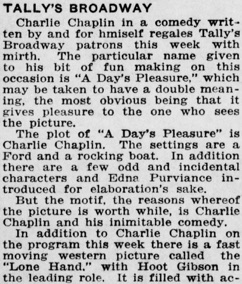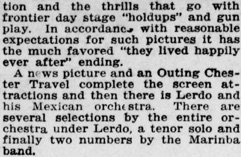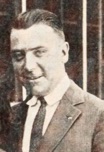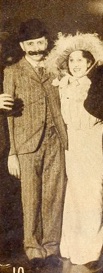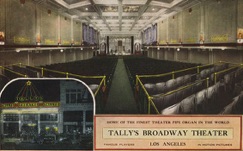The Kid 1920 1922 next previous
Edwin Schallert, Los Angeles Times, L. A., Calif., Dec. 16, 1919.
Ed Schallert
(...) International Photographer, June 1941, detail
& Mr. and Mrs. Edwin Schallert
(...) Modern Screen, Jan. 1934, detail
& Guy Price
(...) Photo, Exhibitors Herald, Oct. 28, 1922, detail
& Tally‘s Broadway Theater, interior.
Home of the Finest Theater Pipe Organ in the World,
Famous Players in Motion Pictures,
Los Angeles, undated, flickr, postcard in color
& TALLY‘S BROADWAY
Charlie Chaplin in a comedy written by and for himself
regales Tally‘s Broadway patrons this this week
with mirth. The particular name given to his bit of fun making
on this occasion is A Day‘s Pleasure, which may
be taken to have a double meaning, the most obvious
being that it gives pleasure to the one who sees
the picture.
The plot of A Day‘s Pleasure is Charlie Chaplin. The
settings are a Ford and a rocking boat. In addition
there are a few odd and incidental characters and Edna
Purviance introduced for elaboration‘s sake.
But the motif, the reasons whereof the picture is worth while,
is Charlie Chaplin and his inimitable comedy.
(...) Guy Price, Los Angeles Herald, Dec. 16, 1919
„The burst of applause which greeted the appearance of the title“
Editorial content. „New Chaplin Comedy.
Nobody quite succeeds in producing the thrill of joy
that Charlie Chaplin evokes whenever his name
flashes on the silversheet, and the audience yesterday
afternoon at Tally‘s Broadway gave evidence
of their anticipation in the ,ahs‘ of expectancy and the burst
of applause which greeted the appearance of the title.
A Day‘s Pleasure.
There is much that is old and some that is brand new
in the latest First National release of the premier
comedian. There is little of Charlie, but much of Chaplin
in the unfolding of the play. In other words, it is
the star as producer, rather than as principal, that is revealed.
Really the opening seems quite unlike the usual
Chaplin picture; you might take it for a Max Linder production.
However, the climax is a striking piece of Chaplinism,
beside which the rest of the feature grows as pale as the
negroes in the jazz band in the seasick scene.
Chaplin neatly satirizes the traffic mix-ups in his final
episode, and he manipulates a tangle that would
make even Seventh on Broadway on Sunday evening look
like midnight on the village turnpike.
After essaying to cross the street at the wrong time,
Charlie finally gets away, leaving the traffic cops
glued to the pavement in the contents of an overturned
tar wagon.
Some of the seasick episodes are good, though not exactly new, while Charlie‘s experience wit the camp chair is full of fun.
In A Day‘s Pleasure we see more of Chaplin as the director
than the actor, and we miss the intimate note of other
comedies, but the picture has novelty that is best apparent
in the climax.“ (...)
Tally‘s Broadway Theater, 833 South Broadway, Los Angeles.
A Day‘s Pleasure is
released by First National December 15, 1919.
Redaktioneller Inhalt
The Kid 1920 1922 next previous

